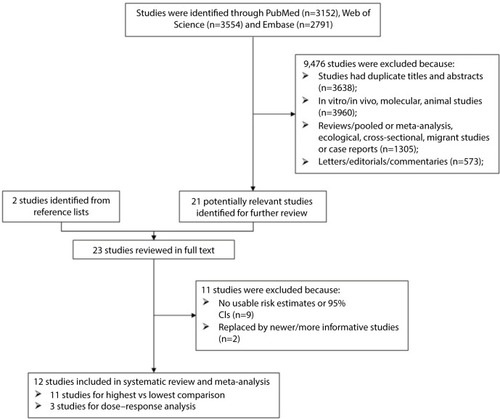Abstract
Purpose
To comprehensively assess the impact of preoperative serum albumin levels on survival of patients with epithelial ovarian cancer (EOC).
Materials and methods
Two independent researchers searched the PubMed, Embase, and Web of Science databases to identify relevant studies from inception to October 20, 2017. The studies were independently reviewed and those deemed eligible were selected based on predetermined selection criteria. Summarized HRs and 95% CIs were calculated for overall survival (OS) with a profile likelihood random-effects model.
Results
Twelve cohort studies comprising 3884 EOC patients were included for analysis. Comparison of the highest vs the lowest categories of preoperative serum albumin yielded a summarized HR of 0.63 (95% CI=0.45–0.88, I2=88.8%). Although the results were robust in all subgroup analyses stratified by International Federation of Gynecology and Obstetrics (FIGO) stage, cutoff definition, geographical location, quality of study, number of EOC cases, followup time, and adjustments made for potential confounders, not all were statistically significant. Of note, dose–response analysis showed that for each 10 g/L increment in preoperative serum albumin level, the summary HR was 0.56 (95% CI=0.35–0.92, I2=78.6%). No evidence of publication bias was detected by funnel plot analysis and formal statistical tests. Sensitivity analyses showed no important differences in the estimates of effects.
Conclusion
The present meta-analysis suggests that preoperative serum albumin can be used as an independent prognostic predictor of OS in EOC patients. Since the included studies had high heterogeneity and retrospective designs, these results require further validation with prospective cohort trials enrolling larger patient populations with longer follow-up examinations.
Introduction
Ovarian cancer accounted for an estimated 2,30,000 new diagnoses and 1,50,000 deaths worldwide in 2012.Citation1 Epithelial ovarian cancer (EOC) is the most common histological type of this disease. However, due to presentation at a late stage of disease and lack of specific symptoms, half of these patients experience recurrence within 16 months and the 5-year overall survival (OS) rate is <50%.Citation2–Citation5 Advanced-stage disease is frequently related to ascites formation, nutritional deficits, weight loss, and poor patient performance. Various prognostic markers, including serum albumin, total protein, transferrin, and hemoglobin levels, are used to evaluate nutritional status in patients with gynecological cancers.Citation6
Albumin is the most abundant plasma protein in humans, accounting for 50%–65% of total serum proteinCitation7 and is produced, but not stored, in the liver, with almost 60% present in the extravascular space.Citation8 Albumin plays a key role in maintaining colloid osmotic pressure and acts as a transport vehicle for intrinsic metabolites, drugs, and antioxidative agents.Citation9 Malignant disease has been shown to be associated with low albumin levels due to inhibitory effects on its synthesis by the liverCitation10 and sequestration in ascites or pleural effusion. The rate of albumin synthesis is associated with nutritional and disease statesCitation11 and has been described as a crucial parameter of long-standing malnutrition.Citation12 These previous experimental studies raised concern as to whether preoperative serum albumin is associated with increased mortality in EOC patients. However, the evidence from previous observational studies is controversial,Citation8,Citation12–Citation22 as some studies have suggested that lower preoperative serum albumin was associated with decreased mortality of EOC,Citation8,Citation12–Citation16,Citation19,Citation21,Citation22 while others failed to find any evidence of such an association.Citation17,Citation18,Citation20
Therefore, to help reconcile these issues, the aim of this systematic review and meta-analysis of all relevant observational studies was to determine the effect of preoperative serum albumin level on survival of patients with EOC.
Patients and methods
Data sources and searches
The reporting standards of the Meta-Analysis of Observational Studies in Epidemiology group for systematic reviews and meta-analyses of nonrandomized controlled trials were followed.Citation23 Two independent researchers (L-NG and FW) searched the PubMed, Embase, and Web of Science databases to identify relevant studies from inception to October 20, 2017, without language restrictions. The following search keywords and terms were used: (“serum albumin” OR “nutrition” OR “serum proteins” OR “hypo-albuminemia” OR “hyperalbuminemia”) AND (“ovary” OR “ovarian”) AND (“cancer” OR “neoplasms” OR “carcinoma” OR “tumor”) AND (“survival” OR “mortality” OR “prognosis”).
Study selection
NoteExpress Research & Reference Manager software was used to identify and remove duplicate records. Subsequently, two researchers (L-NG and FW) independently checked the titles and abstracts of the retrieved articles for relevancy and then examined the full-text articles. Discrepancies were solved through discussion or, if necessary, arbitration by a third reviewer. The following inclusion criteria were used: 1) observational study design; 2) studies investigated the relationship of preoperative serum albumin with progression-free survival and OS of EOC patients; and 3) studies that included HRs or relative risk analyses with 95% CIs or provided data allowing the calculation of the risk estimates and 95% CIs. The following exclusion criteria were used: 1) randomized controlled trials, ecological studies, case–control studies, reviews without original data, editorials, commentaries, meeting abstracts, and case reports and 2) studies that reported risk estimates without 95% CI (eg, studies that could not be included in the statistical summary).
Data abstraction and risk of bias assessment
For each study selected for inclusion, two researchers (L-NG and FW) independently extracted data using a pilot-tested standardized form in Excel format (Micro-soft Corporation, Redmond, WA, USA). The following data were collected: name of first author, year of study, country, number of cases and events, characteristics of patients, characteristics and unit of exposure, outcome, risk estimate, study-specific adjusted risk estimates with 95% CIs, and adjustment for potential confounder information, if applicable.
The Newcastle–Ottawa quality assessment scale for cohort studies was used to assess the risk of bias of the selected studies.Citation24–Citation28 Subsequently, studies that achieved a full rating in at least two categories of selection, comparability, or outcome assessment were considered to have a low risk of bias.Citation29
Statistical analyses
To unify the comparison, the effective-count method proposed by Hamling et alCitation30 was used to recalculate the HRs of studies that did not use the category with the lowest level of serum albumin as the referenceCitation12,Citation15–Citation17 as well as those that only provided the results of dose–response analysis instead of the highest compared with the lowest category.Citation20,Citation22 Overall, summary estimates were calculated using inverse variance-weighted random-effects meta-analysis. Individual HR estimates and summary estimates are displayed graphically as forest plots. Heterogeneity across the studies was quantified using the I2 statistic, which indicates high heterogeneity when I2>75%Citation31 and visually depicted using a Galbraith plot.Citation32 Furthermore, the sequential exclusion strategy propsed by Patsopoulos et al was used to examine whether the overall estimates were influenced by the substantial heterogeneity observed.Citation33 Prespecified subgroup analyses were conducted according to the International Federation of Gynecology and Obstetrics (FIGO) stage (all vs III–IV), cutoff definition (hypoalbuminemia vs others), geographical location (Asia, Europe, and America), quality of study (low vs high risk), median number of EOC cases (≥250 vs <250), median follow-up time (≥2 vs <2 years), and adjustments made for potential confounders (including age at diagnosis, FIGO stage, grade, performance status, residual disease, and ascites). Heterogeneity between subgroups was evaluated by meta-regression analysis. A funnel plot was generated, and the Begg and MazumdarCitation34 and Egger et alCitation35 methods were applied to examine small study biases (eg, publication bias). To assess the effect of individual studies on the estimated relative risk, sensitivity analysis was conducted in which the summarized risk estimates were recalculated by omitting one study at a time. All statistical analyses were performed using Stata 12.0 software (Stata LLC, College Station, TX, USA).
Results
Characteristics and quality assessment of the retrieved studies
The initial searches of the databases returned 9497 articles. After screening the titles and abstracts, 23 articles qualified for a full-text review (). Finally, 12 cohort studiesCitation8,Citation12–Citation21,Citation36 were included in the present analysis.
presents the key characteristics of the included studies. These studies were published from 1994 to 2017 and included a total of 3884 EOC patients with a range of 78–1189 cases in each study. Most (7/12, 58.3%) of the included studies were conducted in Europe,Citation8,Citation15,Citation16,Citation18,Citation20–Citation22 while 4/12 (33.3%) were conducted in Asia,Citation12–Citation14,Citation17 and 1/12 (8.3%) was conducted in the USA.Citation19 Serum albumin was a categorical variable in 9/12 (75.0%) studiesCitation8,Citation12,Citation14–Citation19,Citation21 and a continuous variable in 3/12 (25.0%) studies.Citation13,Citation20,Citation22
Table 1 Characteristics of studies included in the meta-analysis
According to the quality assessment criteria, 10 studiesCitation8,Citation12–Citation17,Citation19–Citation21 were graded as low risk and two studiesCitation18,Citation22 as high risk (). Additionally, based on adjusted confounders, five studiesCitation8,Citation12,Citation16,Citation19,Citation20 met our criteria for adequate adjustment, while the other sevenCitation13–Citation15,Citation17,Citation18,Citation21,Citation22 did not adequately adjust for potential confounders.
Table 2 Methodological quality of studies included in the meta-analysis
Preoperative serum albumin and OS of EOC patients (highest vs lowest category)
Eleven studiesCitation8,Citation12,Citation14–Citation22 reported data of the association between preoperative serum albumin and OS of EOC patients. Comparison of the highest vs the lowest categories of serum albumin yielded a summarized HR of 0.63 (95% CI=0.45–0.88; ), with significant heterogeneity (I2=88.8%; Figure S1). There was no evidence of publication bias based on visual inspection of funnel plots () or according to the Begg’s (p=0.88) or Egger’s tests (p=0.33).
Figure 2 Forest plot (random-effects model) of preoperative serum albumin and overall survival of patients with epithelial ovarian cancer (highest vs lowest).
Notes: The squares indicate study-specific hazard ratio (size of the square reflects the study-specific statistical weight), the horizontal lines indicate 95% CIs, and the diamond indicates the summary hazard ratio estimate with its 95% CI.
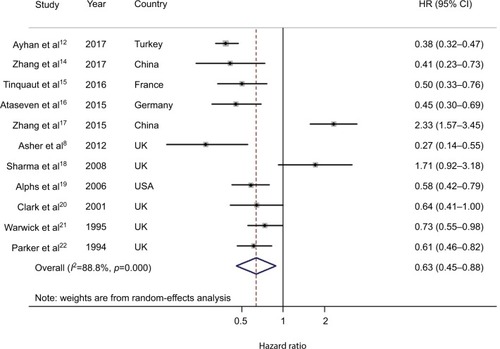
When studiesCitation12,Citation17,Citation21 contributing the largest amount to heterogeneity until I2 was <50% were sequentially excluded, the summarized HR for outcomes (HR=0.55, 95% CI=0.46–0.65, I2=34.9%) were similar to the main results. Additionally, the summarized HR ranged from 0.55 (95% CI=0.43–0.70, I2=75.6%; exclusion of Zhang et alCitation17) to 0.68 (95% CI=0.48–0.95, I2=89.3%; exclusion of Asher et al;Citation8 ). After excluding studies that failed to adjust for any potential confounders, the result was robust (HR=0.51, 95% CI=0.42–0.62), but with moderate heterogeneity (I2=63.8%).
shows the results of subgroup analyses. Although the direction of all subgroup analyses was consistent with the main finding, not all were statistically significant. Importantly, significant results were observed in studies adjusted for these potential confounders. Except for FIGO stage (p=0.015), analysis of meta-regression showed no association between OS and any of the nine subgroup factors ().
Table 3 Risk estimate summary of the association of serum albumin with overall survival of ovarian cancer patients (highest vs lowest)
Dose–response analysis of preoperative serum albumin and OS of EOC patients
Only three studies provided data of dose–response analysis. The results showed that for each 10 g/L increment in preoperative serum albumin concentration, the summary HR was 0.56 (95% CI=0.35–0.92), with high heterogeneity (I2=78.6%; ).
Figure 3 Forest plot (random-effects model) of dose–response analysis of the preoperative serum albumin (per 10 g/L increment) and overall survival of patients with epithelial ovarian cancer.
Notes: The squares indicate study-specific hazard ratio (size of the square reflects the study-specific statistical weight), the horizontal lines indicate 95% CIs, and the diamond indicates the summary hazard ratio estimate with its 95% CI.
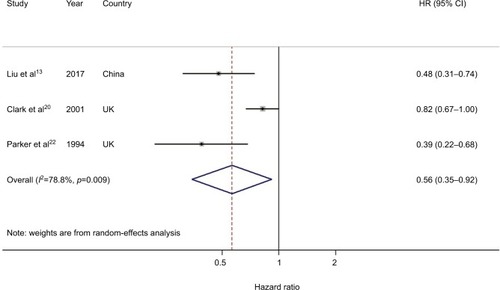
Discussion
The present systematic review and meta-analysis shows that a higher preoperative serum albumin level was associated with better survival of EOC patients. Notably, for each 10 g/L increment in preoperative serum albumin concentration, the survival of EOC patients increased by 44%.
Serum albumin concentration is an important laboratory measurement to evaluate the nutritional status of patients.Citation37,Citation38 Hypoalbuminemia in cancer patients may result from malnutrition, low appetite, weight loss, and cachexia due to the host responses to the tumor and antitumor therapies.Citation12,Citation14 Low intake of amino acids and a negative nitrogen balance and degradation in albumin synthesis are determinants of serum albumin levels.Citation12 It was reported that 24% of patients with gynecological cancers are malnourished, and those with EOC have the highest rate of malnutrition (67%).Citation12,Citation37 On the other hand, it is well recognized that serum albumin level is closely related to inflammation, which is involved in all stages of EOC formation, including initiation, promotion, development, and progression.Citation39,Citation40 An increased inflammatory response with the production of cytokines, such as interleukin-6 and tumor necrosis factor, is detected in many cancers, including EOC.Citation12,Citation41–Citation43
Although the majority (9/12, 75%) of the included studies treated preoperative serum albumin as a categorical variable, the cutoff value for this biomarker varied among these studies due to methodological differences. Among these nine studies,Citation8,Citation12,Citation14–Citation19,Citation21 seven Citation8,Citation14–Citation18,Citation21 defined a cutoff of preoperative serum albumin according to a state of hypoalbuminemia vs non-hypoalbuminemia. Additionally, other two studiesCitation12,Citation19 optimized preoperative serum albumin cutoff values using receiver operating characteristic curves or median values. Furthermore, the definition of hypoalbuminemia varied among these studies. For example, two studies conducted in ChinaCitation14,Citation17 set the cutoff value of hypoalbuminemia at 40 g/L, while studies conducted in France,Citation15 Germany,Citation16 and UKCitation21 set the value at 35 g/L. Interestingly, when summarizing these studies with a consistent definition of hypoalbuminemia, the summarized HR was 0.60 (95% CI=0.38–0.95, I2=80.5%). However, it was unclear which method was most accurate, and none of the cutoff methods was a source of heterogeneity in the meta-regression analysis. Nevertheless, the heterogeneity between these two groups was slightly different (80.5% vs 92.6%, respectively). Future studies are needed to clarify which cutoff method provides the most accurate values to estimate the prognostic risk of EOC.
When interpreting these results, a good understanding of the strengths and limitations of this study is critical. The strengths of this systematic review include the systematic and rigorous approach used to identify observational studies investigating the impact of preoperative serum albumin on OS of EOC patients. Furthermore, the thoroughness of the study selection, data abstraction, and risk of bias assessment should also be mentioned. Of note, the present study provides the largest sample of women for the examination of the aforementioned associations reported to date and also provides the power to investigate whether these associations differed by important study characteristics as well as to conduct detailed sensitivity analyses. The results of these numerous preplanned subgroup and sensitivity analyses were consistent, which suggested that the results were robust. There were, however, some important limitations to consider. First, except for the study by Tinquaut et alCitation15 in a pooled analysis of three Phase II trials, the majority of the included studies were retrospective chart reviews, which may bear a potential risk of selection bias and information bias even though the data were obtained from hospital records. However, no other related prospective study was found through our search strategy. Second, the majority of results had high levels of heterogeneity, which was not unexpected, and might have been caused by differences in FIGO stage, cutoff definition, geographical location, study quality, number of cases, follow-up time, and adjustment for potential confounders. Specifically, the results of the meta-regression analysis showed statistical significance after adjustment for FIGO stage, which suggested that this factor might be a source of heterogeneity. Of note, moderate or low heterogeneity was observed after summarizing the studies adjusted for these potential confounders as well as excluding those that failed to adjust for potential confounders. Third, although preoperative serum albumin had a strong impact on the OS of EOC patients, residual confounding from unmeasured or incomplete variables could not be ruled out due to the inherit characteristics of meta-analysis of observational studies. Preoperative serum albumin concentrations are typically associated with other clinical and nonclinical characteristics, such as histology, FIGO stage, ascites, comorbidity, performance status, and weight loss.Citation12,Citation36 Many, but not all, of the studies adjusted for potential confounding factors, although not all potential confounders were adjusted for in every study. Importantly, only one of the included studiesCitation14 adjusted the primary analysis for systemic inflammatory response markers (eg, neutrophil to lymphocyte ratio, C-reactive protein, and absolute white blood cell count), which have been suggested as independent prognostic factors. Hence, further studies fully adjusted for these confounders are warranted. Fourth, few of the included studies treated preoperative serum albumin as a continuous variable in the primary multivariate analyses; therefore, it was not possible to evaluate dose–response associations between preoperative serum albumin and OS of EOC patients or to test whether a nonlinear association existed. Further studies with sufficient data to conduct dose–response analyses are warranted in the future.
Conclusion
The results of this dose–response meta-analysis suggest that higher preoperative serum albumin levels are associated with better prognosis of EOC patients. Preoperative serum albumin might be used for preoperative evaluation of EOC patients and for risk prediction in clinical practice. These findings were consistent with the 2002 American Society for Parenteral and Enteral Nutrition guidelines and the European guidelines, which recommend that cancer patients with severe nutritional risk should receive nutritional support for 1–2 weeks prior to a major surgery.Citation44,Citation45
Supplementary materials
Figure S1 Galbraith plot corresponding to the relationship between pre-operative serum albumin and overall survival of patients with epithelial ovarian cancer.
Abbreviation: SE, standard error.
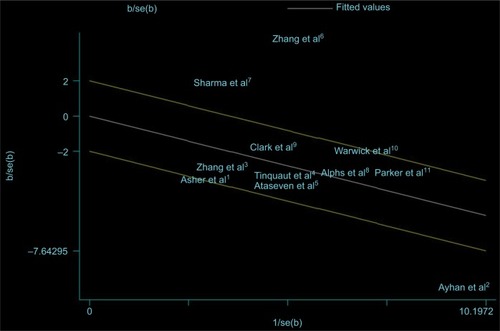
Figure S2 Funnel plots for detection for publication bias.
Abbreviations: HR, hazard ratio; SE, standard error.
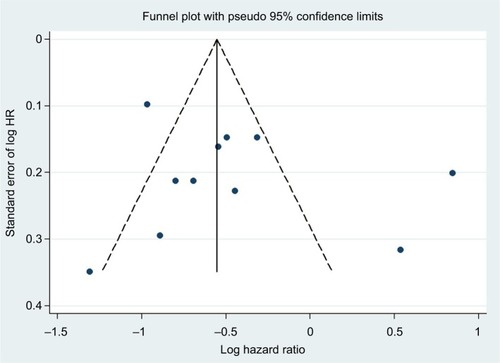
Figure S3 Sensitivity analysis of the association between pre-operative serum albumin and overall survival of patients with epithelial ovarian cancer.
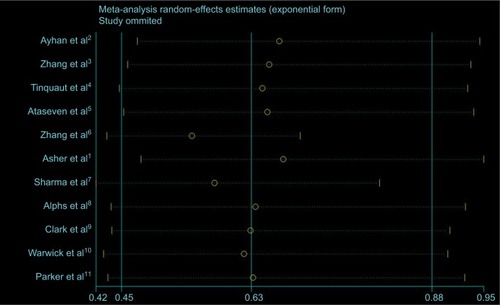
References
- AsherVLeeJBaliAPreoperative serum albumin is an independent prognostic predictor of survival in ovarian cancerMed Oncol20122932005200921735143
- AyhanAGunakanEAlyaziciIHaberalNAltundagODursunPThe preoperative albumin level is an independent prognostic factor for optimally debulked epithelial ovarian cancerArch Gynecol Obstet2017296598999528875365
- ZhangHLuJLuYPrognostic significance and predictors of the system inflammation score in ovarian clear cell carcinomaPlos One2017125e177520
- TinquautFFreyerGChauvinFGaneNPujade-LauraineEFalandryCPrognostic factors for overall survival in elderly patients with advanced ovarian cancer treated with chemotherapy: Results of a pooled analysis of three GINECO phase II trialsGynecol Oncol20161431222627045777
- AtasevenBdu BoisAReinthallerAPre-operative serum albumin is associated with post-operative complication rate and overall survival in patients with epithelial ovarian cancer undergoing cytoreductive surgeryGynecol Oncol2015138356056526163893
- ZhangWWLiuKJHuGLLiangWJPreoperative platelet/lymphocyte ratio is a superior prognostic factor compared to other systemic inflammatory response markers in ovarian cancer patientsTumour Biol201536118831883726063409
- SharmaRHookJKumarMGabraHEvaluation of an inflamma-tionbased prognostic score in patients with advanced ovarian cancerEur J Cancer200844225125618155897
- AlphsHHZahurakMLBristowREDiaz-MontesTPPredictors of surgical outcome and survival among elderly women diagnosed with ovarian and primary peritoneal cancerGynecol Oncol200610331048105316876237
- ClarkTGStewartMEAltmanDGGabraHSmythJFA prognostic model for ovarian cancerBr J Cancer200185794495211592763
- WarwickJKehoeSEarlHLuesleyDRedmanCChanKKLong-term follow-up of patients with advanced ovarian cancer treated in randomised clinical trialsBr J Cancer1995726151315178519669
- ParkerDBradleyCBogleSMSerum albumin and CA125 are powerful predictors of survival in epithelial ovarian cancerBr J Obstet Gynaecol1994101108888937999691
Disclosure
The authors report no conflicts of interest in this work.
References
- TorreLABrayFSiegelRLFerlayJLortet-TieulentJJemalAGlobal cancer statistics, 2012CA Cancer J Clin20156528710825651787
- MarkmanMBundyBNAlbertsDSPhase III trial of standard-dose intravenous cisplatin plus paclitaxel versus moderately high-dose carboplatin followed by intravenous paclitaxel and intraperitoneal cisplatin in small-volume stage III ovarian carcinoma: an intergroup study of the Gynecologic Oncology Group, Southwestern Oncology Group, and Eastern Cooperative Oncology GroupJ Clin Oncol20011941001100711181662
- FengZWenHBiRPreoperative neutrophil-to-lymphocyte ratio as a predictive and prognostic factor for high-grade serous ovarian cancerPLoS One2016115e156101
- BerekJSCrumCFriedlanderMCancer of the ovary, fallopian tube, and peritoneumInt J Gynaecol Obstet2015131Suppl 2S111S22226433667
- LedermannJARajaFAFotopoulouCGonzalez-MartinAColomboNSessaCNewly diagnosed and relapsed epithelial ovarian carcinoma: ESMO clinical practice guidelines for diagnosis, treatment and followupAnn Oncol201324Suppl 6i24i32
- LakyBJandaMBauerJVavraCCleghornGObermairAMalnutrition among gynaecological cancer patientsEur J Clin Nutr200761564264617021596
- FanaliGdi MasiATrezzaVMarinoMFasanoMAscenziPHuman serum albumin: from bench to bedsideMol Aspects Med201233320929022230555
- AsherVLeeJBaliAPreoperative serum albumin is an independent prognostic predictor of survival in ovarian cancerMed Oncol20122932005200921735143
- MendezCMMcClainCJMarsanoLSAlbumin therapy in clinical practiceNutr Clin Pract200520331432016207669
- AnderssonCELonnrothICGelinLJMoldawerLLLundholmKGPretranslational regulation of albumin synthesis in tumor-bearing mice. The role of anorexia and undernutritionGastroenterology199110049389451900492
- NicholsonJPWolmaransMRParkGRThe role of albumin in critical illnessBr J Anaesth200085459961011064620
- AyhanAGunakanEAlyaziciIHaberalNAltundagODursunPThe preoperative albumin level is an independent prognostic factor for optimally debulked epithelial ovarian cancerArch Gynecol Obstet2017296598999528875365
- LiuYChenSZhengCThe prognostic value of the preoperative c-reactive protein/albumin ratio in ovarian cancerBmc Cancer201717128528431566
- ZhangHLuJLuYPrognostic significance and predictors of the system inflammation score in ovarian clear cell carcinomaPlos One2017125e177520
- TinquautFFreyerGChauvinFGaneNPujade-LauraineEFalandryCPrognostic factors for overall survival in elderly patients with advanced ovarian cancer treated with chemotherapy: results of a pooled analysis of three GINECO phase II trialsGynecol Oncol20161431222627045777
- AtasevenBdu BoisAReinthallerAPre-operative serum albumin is associated with post-operative complication rate and overall survival in patients with epithelial ovarian cancer undergoing cytoreductive surgeryGynecol Oncol2015138356056526163893
- ZhangWWLiuKJHuGLLiangWJPreoperative platelet/lymphocyte ratio is a superior prognostic factor compared to other systemic inflammatory response markers in ovarian cancer patientsTumour Biol201536118831883726063409
- SharmaRHookJKumarMGabraHEvaluation of an inflammation-based prognostic score in patients with advanced ovarian cancerEur J Cancer200844225125618155897
- AlphsHHZahurakMLBristowREDiaz-MontesTPPredictors of surgical outcome and survival among elderly women diagnosed with ovarian and primary peritoneal cancerGynecol Oncol200610331048105316876237
- ClarkTGStewartMEAltmanDGGabraHSmythJFA prognostic model for ovarian cancerBr J Cancer200185794495211592763
- WarwickJKehoeSEarlHLuesleyDRedmanCChanKKLong-term follow-up of patients with advanced ovarian cancer treated in randomised clinical trialsBr J Cancer1995726151315178519669
- ParkerDBradleyCBogleSMSerum albumin and CA125 are powerful predictors of survival in epithelial ovarian cancerBr J Obstet Gynaecol1994101108888937999691
- StroupDFBerlinJAMortonSCMeta-analysis of observational studies in epidemiology: a proposal for reporting. Meta-analysis Of Observational Studies in Epidemiology (MOOSE) groupJAMA2000283152008201210789670
- WellsGASheaBO’ConnellD [webpage on the Internet]The Newcastle-Ottawa Scale (NOS) for assessing the quality of nonrandomised studies in meta-analyses Available from: http://www.ohrica/programs/clinical_epidemiological/oxford.aspAccessed December 16, 2017
- WuQJWuLZhengLQXuXJiCGongTTConsumption of fruit and vegetables reduces risk of pancreatic cancer: evidence from epidemiological studiesEur J Cancer Prev201625319620526075658
- HuangYCaiXMaiWLiMHuYAssociation between prediabetes and risk of cardiovascular disease and all cause mortality: systematic review and meta-analysisBMJ2016355i595327881363
- BenQSunYChaiRQianAXuBYuanYDietary fiber intake reduces risk for colorectal adenoma: a meta-analysisGastroenterology20141463689.e6699.e624216326
- AuneDSaugstadODHenriksenTTonstadSMaternal body mass index and the risk of fetal death, stillbirth, and infant death: a systematic review and meta-analysisJAMA2014311151536154624737366
- OdutayoAWongCXHsiaoAJHopewellSAltmanDGEmdinCAAtrial fibrillation and risks of cardiovascular disease, renal disease, and death: systematic review and meta-analysisBMJ2016354i448227599725
- HamlingJLeePWeitkunatRAmbuhlMFacilitating meta-analyses by deriving relative effect and precision estimates for alternative comparisons from a set of estimates presented by exposure level or disease categoryStat Med200827795497017676579
- HigginsJPThompsonSGQuantifying heterogeneity in a meta-analysisStat Med200221111539155812111919
- YaoXTianZSaturated, monounsaturated and polyunsaturated fatty acids intake and risk of pancreatic cancer: evidence from Observational StudiesPLoS One2015106e130870
- PatsopoulosNAEvangelouEIoannidisJPSensitivity of between-study heterogeneity in meta-analysis: proposed metrics and empirical evaluationInt J Epidemiol20083751148115718424475
- BeggCBMazumdarMOperating characteristics of a rank correlation test for publication biasBiometrics1994504108811017786990
- EggerMDaveySGSchneiderMMinderCBias in meta-analysis detected by a simple, graphical testBMJ199731571096296349310563
- UppalSAl-NiaimiARiceLWPreoperative hypoalbuminemia is an independent predictor of poor perioperative outcomes in women undergoing open surgery for gynecologic malignanciesGynecol Oncol2013131241642223962700
- LakyBJandaMCleghornGObermairAComparison of different nutritional assessments and body-composition measurements in detecting malnutrition among gynecologic cancer patientsAm J Clin Nutr20088761678168518541556
- McIntoshENLaurentLLNutritional assessment of the hospitalized patientAm Fam Physician19832711691756401905
- MantovaniAAllavenaPSicaABalkwillFCancer-related inflammationNature2008454720343644418650914
- CoussensLMWerbZInflammation and cancerNature2002420691786086712490959
- SimonsJPScholsAMBuurmanWAWoutersEFWeight loss and low body cell mass in males with lung cancer: relationship with systemic inflammation, acute-phase response, resting energy expenditure, and catabolic and anabolic hormonesClin Sci (Lond)199997221522310409477
- O’GormanPMcMillanDCMcArdleCSImpact of weight loss, appetite, and the inflammatory response on quality of life in gastrointestinal cancer patientsNutr Cancer199832276809919615
- BarberMDRossJAFearonKCChanges in nutritional, functional, and inflammatory markers in advanced pancreatic cancerNutr Cancer199935210611010693162
- WeimannABragaMHarsanyiLESPEN (European Society for Parenteral and Enteral Nutrition)ESPEN guidelines on enteral nutrition: surgery including organ transplantationClin Nutr200625222424416698152
- HuhmannMBAugustDANutrition support in surgical oncologyNutr Clin Pract200924452052619605805
- WellsGASheaBO’ConnellD [webpage on the Internet]The Newcastle-Ottawa Scale (NOS) for assessing the quality of nonrandomized studies in meta-analyses Available from: http://www.ohri.ca/programs/clinical_epidemiologyAccessed December 16, 2017

